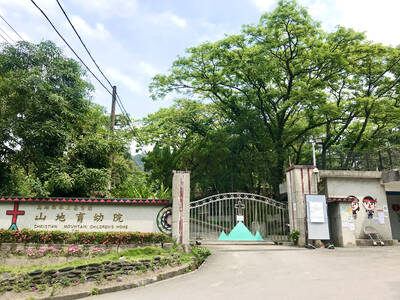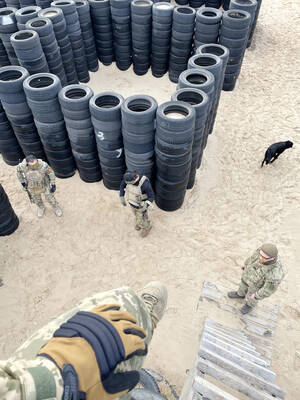Apparently it’s no longer enough to simply book a spa massage when you’re on vacation. For a new wave of wellness-seeking millennials, only the latest, and often personalized, forms of treatments will do.
“Fifteen years ago, we used to do sugar scrubs and chocolate facials — it was only about indulgence,” said Kristi Dickinson, the director of spa and fitness at Rancho Valencia in Rancho Santa Fe, California. “Today, people are looking to the spa as a lifestyle resource.”
That means that, along with a massage, a guest may sign up for the hotel’s “neuroplasty program,” which creates a specialized regimen (often a combination of meditation, exercise and yoga) to boost brain function.

Photo: AP
And if you suspect it’s only millennials who are interested in the new and New Age, you would be wrong. Dickinson’s clients are often in the 40 to 60 age range. “Now their friend at the golf club is doing the latest meditation, too,” she said.
THE ARTS OF HEALING
A slick new hotel seems to sprout in Miami Beach every season, but the Faena Hotel aims to stand out.
Its spa, exotically named the Tierra Santa Healing House, isn’t content with meditation gurus. The wellness director, Vivianne Garcia-Tunon, enlisted a well-known Mexican shaman, Carlos Gomez, to headline its Shaman Purification Ritual.
Gomez has since trained the Tierra Santa staff (he is in residence at the hotel once a quarter if you want to book him in person) on the art of copaleada, which is about cleansing and purifying the body before healing.
“We use copal, which is a resin and is similar to an incense,” Garcia-Tunon said, “and the shaman salutes the earth, the heavens, the sun, north, south, east and west. And as the client journeys through this, the shaman is invoking all these different spirits from the heaven.”
The ritual can be paired with a “unique healing arts” treatment, like the spa’s sound bowl therapy, which is said to heal through vibrations. Be prepared to spend about two hours and US$400.
“Everybody is extremely stressed,” Garcia-Tunon said. “Maybe vacationers don’t want to spend their time drinking by the pool every day. They’ll go home tired, and the vacation will defeat the purpose. They want to feel and look rejuvenated.”
ONE TREATMENT DOES NOT FIT ALL
Besides the neuroplasty regimens, Dickinson will be incorporating a somatotype program into the Rancho Valencia spa menu next month. Clients will be categorized as one of three body types (ecto, endo or meso, based on their body shape and other characteristics), according to rules laid down by the somatotype founder, William H. Sheldon (who died in 1977), with specific products recommended for each.
“The idea is to replenish the nutrients and minerals you need specifically for your body type,” Dickinson explained. That means that plenty of algae and essential oils are deployed in treatments like the Vitality Ritual (90 minutes, US$275), which begins with dry-skin brushing and is followed by a body cleanse, mineral-heavy body wrap, head massage and breathing meditation.
A SOOTHING RUSH
In need of a (holistic) bump? Coca leaves, the raw material from which cocaine comes, is the star ingredient in the signature Inkaterra Therapy treatment (three hours, US$190) at the Inkaterra Machu Picchu Pueblo hotel’s Unu spa.
Along with a detox session in an Andean sauna, the service features a lymphatic drainage massage with coca oil followed by a body mask of coca leaf. Sandra Masias, the product and service manager of Inkaterra Hotels, says that coca leaf contains “alkaloids that activate skin cells, circulation and, in turn, the lymphatic system, helping the body eliminate waste.”
To complete the buzz-building experience, your limbs will be slathered with coca cream before you exit the treatment room.

May 18 to May 24 Pastor Yang Hsu’s (楊煦) congregation was shocked upon seeing the land he chose to build his orphanage. It was surrounded by mountains on three sides, and the only way to access it was to cross a river by foot. The soil was poor due to runoff, and large rocks strewn across the plot prevented much from growing. In addition, there was no running water or electricity. But it was all Yang could afford. He and his Indigenous Atayal wife Lin Feng-ying (林鳳英) had already been caring for 24 orphans in their home, and they were in

On May 2, Chinese Nationalist Party (KMT) Chairman Eric Chu (朱立倫), at a meeting in support of Taipei city councilors at party headquarters, compared President William Lai (賴清德) to Hitler. Chu claimed that unlike any other democracy worldwide in history, no other leader was rooting out opposing parties like Lai and the Democratic Progressive Party (DPP). That his statements are wildly inaccurate was not the point. It was a rallying cry, not a history lesson. This was intentional to provoke the international diplomatic community into a response, which was promptly provided. Both the German and Israeli offices issued statements on Facebook

Even by the standards of Ukraine’s International Legion, which comprises volunteers from over 55 countries, Han has an unusual backstory. Born in Taichung, he grew up in Costa Rica — then one of Taiwan’s diplomatic allies — where a relative worked for the embassy. After attending an American international high school in San Jose, Costa Rica’s capital, Han — who prefers to use only his given name for OPSEC (operations security) reasons — moved to the US in his teens. He attended Penn State University before returning to Taiwan to work in the semiconductor industry in Kaohsiung, where he

President William Lai (賴清德) yesterday delivered an address marking the first anniversary of his presidency. In the speech, Lai affirmed Taiwan’s global role in technology, trade and security. He announced economic and national security initiatives, and emphasized democratic values and cross-party cooperation. The following is the full text of his speech: Yesterday, outside of Beida Elementary School in New Taipei City’s Sanxia District (三峽), there was a major traffic accident that, sadly, claimed several lives and resulted in multiple injuries. The Executive Yuan immediately formed a task force, and last night I personally visited the victims in hospital. Central government agencies and the